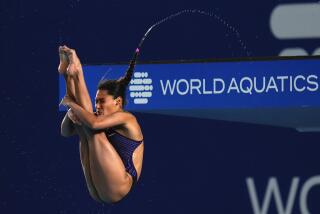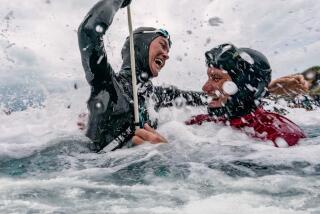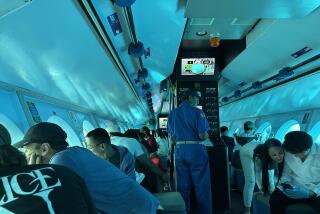TAKING THE PLUNGE : More Diving Enthusiasts Are Discovering Undersea World
- Share via
Like astronauts who return to this planet with a heavenly vision and no earthly words to convey it, scuba divers often find it frustrating to describe the shimmering seascape they have seen.
“They can’t communicate the Zen experience of it,” said Harry Averill, a diving instructor and editor of scuba trade publications for Divers Equipment Manufacturers Assn.
That is one reason why scuba diving, often called the silent sport, has been slow to catch on with the public, say experts like Averill and Alex Irving of the Professional Assn. of Diving Instructors.
But that is changing. This year, almost 350,000 new divers--a third of them women--will join 4.5 million or so already-certified divers in this country, Averill estimates.
Even the fashion world is feeling the scuba influence. Diver watches are hot; bright-colored sportswear and accessories made of neoprene, the fabric of wet suits, are the rage.
These trends are producing new kinds of scuba enthusiasts. No longer just macho daredevils seeking a brute sport, the new divers are men and women of all ages from all walks of life looking for a new experience. “People today are more into so-called adventurous sports, and they are also more in tune with their environment,” said Jennifer King, District 3 representative for the L.A. County Underwater Instructors Assn.
She said scuba diving offers a distinctive experience: “Picture yourself, gliding effortlessly through a kelp forest, suspended weightless in a shimmering column of water teeming with brightly colored marine life. You see this world in a way you never have before. It’s really the only sport that allows you to get away from it all and experience a totally different environment.”
Averill said divers compared their experience to “going to the moon. You put on this exotic equipment and you go to this alien place.”
There are two kinds of diving: “skin” or “free” diving, and scuba diving.
Skin diving also is known as snorkeling. Its participants hold their breath or use a tube to breathe underwater, keeping them free of the burden of tanks. Californians long have enjoyed this style of diving. In the 1930s, a group of young men, interested in discovering what was off the California coast, formed a group called the “bottom scratchers” in San Diego, King said, adding the divers “used Japanese-type goggles, no fins and only woolen clothing for thermal protection.”
Southern California also had a historic role in the development of scuba diving, whose techniques and equipment often were fostered in the area, particularly by the sport’s best-known pioneer, Jacques Cousteau, King said.
“Cousteau, with the help of Emile Gagnan, is credited with developing the first Aqualung in the early ‘40s, and for inventing the acronym scuba --self-contained underwater breathing apparatus,” she said. “The tank makes up the self-contained part and the regulator is the underwater breathing apparatus.”
Scuba diving in its early days was a difficult, often dangerous sport. The gear was heavy and bulky. The process of learning to dive was complicated, partly because students lacked clear, standard methods. “Scuba courses were real long,” Averill said. “You weren’t a student in those days, you were a disciple.”
Seeking to formalize diving instruction, the Los Angeles Parks and Recreation Department helped to develop the first organized scuba instruction in the nation in Los Angeles County in 1954. This effort eventually resulted in the formation of the underwater teachers’ group, which today boasts 70 instructors who continue to teach diving with an emphasis on safety.
Scuba diving--popularized in the ‘50s by Cousteau’s televised “The Silent World” program and later by the TV series “Sea Hunt” starring Lloyd Bridges--has come a long way.
Lightweight, Streamlined
Today’s gear is lightweight and streamlined. It is available in transparent plastics and designer colors. Divers can be trained and certified now in a month. To scuba dive, prospective divers simply must master: the breathing apparatus; getting in and out of the water; ascents and descents; buoyancy control; the use of fins and clearing the mask of water, and the planning of a dive.
The changes in the sport have altered its demographics. Just 15 years ago, only 1-of-10 divers was a woman; few students were over age 25 or 26. But there has been a dramatic increase in the number of women and older divers, said Alex Irving, an instructor and advertising and promotion manager for the professional diving instructors’ group. He observed that “in a recent class, only one student was under the age of 30,” and “not long ago, a woman in her 70s was certified.”
Divers now need not be excellent swimmers. If they can swim and float, are not grossly overweight or out of shape and have no respiratory illnesses, such as asthma, they should be able to enjoy the sport, regardless of age.
Fewer Accidents
And each year, as training methods improve, there are fewer accidents. “We don’t have hard data comparing how many exposures there are to how many accidents, but we know it is steadily improving,” said Dennis Graver, director of education for the National Assn. of Underwater Instructors, which requires students to learn rescue techniques to qualify for certification.
Scuba diving also is gaining new appeal for a special segment of the population, the disabled. The Handicapped Scuba Assn., founded in 1981 by Jim Gatacre of San Clemente, has shown hundreds of mildly to severely disabled people just how the water can give them the mobility and equality that escapes them on land.
Diving need not be a strenuous sport. Being underwater, wearing a tank, wet suit and fins is much easier than swimming, experts say.
“Sometimes I wonder why we expend so much energy swimming on the surface when we can scuba dive,” Irving said. “You learn to keep your hands to your side, kicking your feet and letting them do all the work. The trick is staying horizontal and simplifying your movements. It’s the most natural way for a body to move in the water.”
Looking for Ships
Beginners initially are just enthralled with looking around. When the new environment feels less alien, they begin to think about taking photographs, collecting game or exploring caves and old wrecks. “A big ship is completely outside the experience of most people,” Averill said. “But to find one underwater, especially of another era, is a wonderful and fascinating experience.”
Some divers expand their expertise to include wall diving, in which they hover, motionless, at various depths to enjoy the breathtaking view of underwater walls surrounding many islands. Others learn night diving, which extends their chances to dive and affords them the opportunity to view creatures that only come out after dark.
These specialties, along with the various levels of training, keep the sport interesting to those with numerous dives under their weight belts.
Introductions to diving, sometimes called splash parties, are offered free or at minimal cost through dive shops, the underwater teachers’ group and various diving groups. The events let prospective divers try the sport in the safety of a swimming pool without investing a lot of time and money.
Certification courses, varying in price from $200 to $500, depending on what is included, are 30 to 50 hours of instruction over a three- to four-week period. Generally needed are a mask, snorkel, fins and gloves. Other equipment can be rented.
More to Read
Sign up for The Wild
We’ll help you find the best places to hike, bike and run, as well as the perfect silent spots for meditation and yoga.
You may occasionally receive promotional content from the Los Angeles Times.






